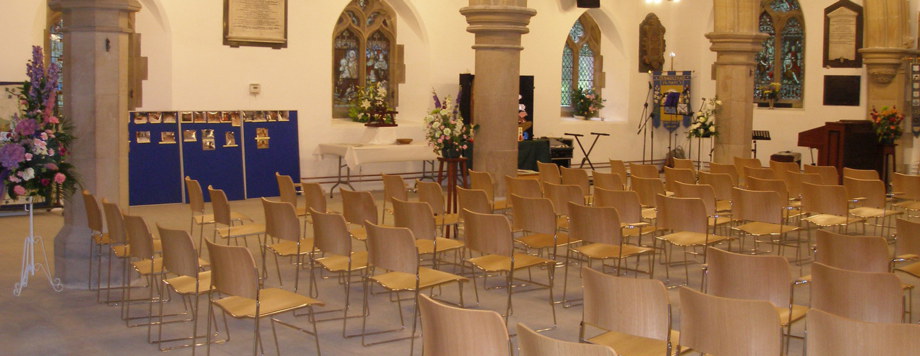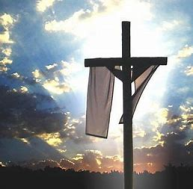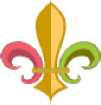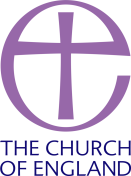
The Tower and Bells
The Tower
The Tower is in the perpendicular style. It has a projecting vice in the south east corner, and on a
gargoyle on the south side is a defaced shield.
The belfry windows are of two lights with cinquefoiled (five leaf) heads and tracery under a pointed arch and hood mould. The south and west belfry windows were sealed internally with light
concrete blocks to within about one foot of the top in 1970 in order to improve the sound of the bells in the churchyard below.
The glass in the west window of the Tower can best be viewed from the ringing loft when supervised access can be obtained. In the top lights are the Greek capital letters alpha and omega, and
two stars of David. It is sai that this window was put in the late 19th century or early 20th century as a memorial to the Rawstorne family and that it bore the Achievements of the Diocese of
Lichfield, Chester and Manchester. These Achievements do not now appear in the window, although shields from the earlier period do. In the left and right hand lights are two
imprecisely executed shields: in the left, argent three chevrons gules impaling azure three martlets or; in the right the shield is even more indistinct; a quartering with chevrons impales
three martlets. These two shields appear to be cheap Victorian work. More attractive is the shield in the centre light: gules three lions passant regardant or. This would be early 19th
century or 18th century. Below it is a crudely executed modern shield, argent a cross or, breaking a cardinal rule of heraldry.
The Clock
There has been a clock in the tower for a long time. In the 17th century it was the minister’s job to wind it. In 1887 Hewitson remarked that its diamond face “would not we believe, object to a new coat of paint and gold leaf”. 1959 saw the end of the hard work of winding the clock, when the sprawling clockwork mechanism was replaced by a small box containing an electric motor.
The Bells
First mention of bells at Penwortham is in the Inventory of Church Goods (1552), which credits the Church
with “thre bells…ij sacring bells”. Sacring bells were - and in many church still are - used during the Communion service. But the two (ij) that were at Penwortham were probably little
used after the reformation and in 1636 seem to have been given to the Minister as payment for looking after the Church clock.
In 1712 there were four bells in the tower. They were than recast into a ring of five by Abraham Rudhall of Gloucester at “his founding house in Preston”. The five new bells were hung in
a frame with space for another bell to be added later.
The additional bell arrived in 1858, cast by Taylor of Loughborough but the frame, so thoughtfully constructed to accommodate it over a century before was not to last much longer. In 1890 a local contractor, J. Walmsley, installed a new frame.
By this time the new bell was proving unsatisfactory, and was recast by the Whitechapel foundry in the following year.
The frame was strengthened and enlarged in 1926. One bell was recast, the other five retuned, and two more added to make an octave. These operation were carried out by the Whitechapel foundry, who alo hung the bells on ball bearings to make ringing easier. The same foundry recast the entire octave in 1965, so that the Church continues to have a ring of bells that measure up to the glowing reputation that the bells have had since the 18th century.
Inscription on the Bells
Each bell is inscribed on its lower waist:
RECAST
19 O 65
With the trademark of the Whitechapel foundry in the middle of the date.
Treble
Cast 1926, recast 1965; note A; weight 145 kg
On Shoulder: M & S LONDON
On Waist: REV. T.J. CUNNINGHAM GAVE THIS BELL IN MEMORY OF HIS BELOVED WIFE ADA CUNNINGHAM 1926
Second
Cast 1926, recast 1965; note G sharp; weight 157 kg
On Shoulder: M & S LONDON
On Waist: LIEUT:COL J.Y.FOSTER GAVE THIS BELL IN MEMORY OF HIS BELOVED WIFE ELISABETH STEUAT FOSTER
Third
Cast 1858, recast 1891, recast 1965; note F sharp, weight 176 kg
On Shoulder: TAYLOR AND SON LOBOR 1858
On Waist: RECAST BY MEARS AND STAINBANK LONDON AT MARY RAWSTORNES COST 1891
Fourth
Cast 1712, recast 1965; note E, weight 208 kg
On Shoulder: GOD SAVE QUEEN ANNE A R 1712
Fifth
Cast 1712, recast 1926, recast 1965; note D; weight 249 kg
On Shoulder: PROSPERITY TO THE CHURCH OF ENGLAND 1712
On Waist: THIS BELL WAS RECAST AT THE COST OF W.S RAWKINS ESQ
IN MEMORY OF HIS MOTHER ELIZA REGENT RAWKINS 1926
Sixth
Cast 1712, recast 1965; note C sharp, weight 258 kg
On Shoulder: ABR: RUDHALL CAST US ALL ANNO DOM 1712
Seventh
Cast 1712, recast 1965; note B; weight 346 kg
On Shoulder: RALPH LOXAM MINISTER A R 1712
Tenor
Cast 1712, recast 1965; note B; weight 435 kg
On Shoulder: WM: SLATER EVAN MAUDSLEY WM FARINGTON WM BICKERSTAFF WARDENS 1712
On Waist below Whitechapel trademark: MEARS LONDON




